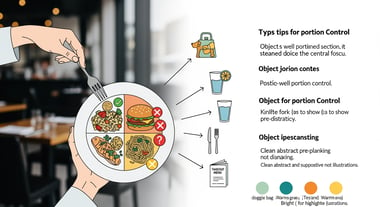As Master Kim, the Strategic Roadmaps Architect for BeSlim.me, I specialize in dissecting diet strategies with a keen eye on evidence-based outcomes. Today, we're diving into the method of using a food scale for precise calorie counting—a foundational tool in many weight management plans. This guide is designed to be your strategic blueprint, blending analytical insights with practical steps. We'll explore the pros and cons, provide a phased implementation roadmap, highlight risks, and arm you with immediate actions. Remember, while food scales enhance accuracy, sustainable weight loss requires a holistic approach, including balanced nutrition and professional advice.
| Pros | Cons |
|---|---|
| Enhances Portion Control Accuracy: Weighing food provides precise measurements, reducing estimation errors that can lead to overeating. | Initial Learning Curve: Requires time to learn calibration and usage, which might feel overwhelming for beginners. |
| Supports Evidence-Based Weight Loss: Studies show accurate tracking correlates with better adherence to calorie goals, aiding long-term success. | Potential for Obsessive Behavior: Over-reliance can lead to unhealthy fixation on numbers, potentially triggering disordered eating patterns. |
| Versatile for Various Diets: Compatible with low-carb, intermittent fasting, or macro-based plans, allowing customization. | Cost and Convenience: Quality scales cost $20–$50, and weighing every meal can be time-consuming in busy lifestyles. |
| Improves Nutritional Awareness: Encourages mindfulness about food density, helping users make informed choices. | Not Foolproof for All Foods: Liquid or irregularly shaped items may require additional tools, complicating the process. |
Why Use a Food Scale for Calorie Counting?
Calorie counting remains a cornerstone of many diet strategies, but eyeballing portions often leads to inaccuracies—studies estimate that people underestimate calorie intake by up to 20-50% when relying on visual cues alone. A food scale addresses this by offering gram-level precision, making it easier to align with daily energy needs. This method isn't about restriction but empowerment: it equips you with data to make strategic decisions.
From a clinical perspective, accurate tracking has been linked to improved weight management outcomes. For instance, research on portion control tools shows food scales improve calorie estimation accuracy, leading to better adherence in structured diets. However, it's not a magic bullet—pair it with balanced eating to avoid nutrient deficiencies.
Risk Warning: While food scales promote precision, they carry potential downsides. Overuse may contribute to anxiety or eating disorders in susceptible individuals, such as those with a history of restrictive behaviors. Contraindications include anyone under medical supervision for eating disorders; consult a healthcare provider first. Unsustainability arises if it becomes a crutch, ignoring intuitive eating signals—long-term, this could lead to burnout or yo-yo dieting. Always integrate it into a broader, evidence-based plan.
Step-by-Step Implementation Guide
To integrate a food scale into your routine effectively, we'll break it down into a phased roadmap. This isn't a rigid timeline but a strategic progression: Phase 1 focuses on setup and basics (Weeks 1-2), Phase 2 on integration and tracking (Weeks 3-4), and Phase 3 on optimization and sustainability (Ongoing). Aim for consistency, tracking progress in a journal or app. Backed by evidence, this approach draws from studies showing gradual habit-building enhances adherence—NIH guidelines on behavioral weight loss emphasize phased tracking for lasting results.
Phase 1: Setup and Basics (Weeks 1-2)
Start simple to build confidence without overwhelm. The goal here is familiarity, not perfection.
Choose and Calibrate Your Scale: Invest in a digital kitchen scale with tare function (resets to zero) and gram/ounce measurements. Budget options under $30 work fine. Calibrate it on a flat surface—place a known weight (like a 100g item) and ensure it reads accurately. Tip: Avoid cheap analog scales; digital ones offer better precision.
Learn Key Functions: Practice weighing common items. For example, tare a bowl, add ingredients one by one, and note weights. Understand units: Use grams for solids and milliliters for liquids if your scale supports it.
Start with One Meal: Begin with breakfast. Weigh portions like oatmeal (e.g., 50g dry) or fruit (e.g., 150g apple). Log calories using an app like MyFitnessPal, which integrates scale data.
Weekly Check-In: At week's end, review logs. Did weighing reveal surprises, like how a "handful" of nuts is actually 200 calories? Adjust goals based on your basal metabolic rate (calculate via online tools).
By the end of Phase 1, you'll have weighed 10-15 items, building a mental database. This phase is crucial as initial accuracy training can reduce calorie misestimation by 15-30%, per portion control research.
Phase 2: Integration and Tracking (Weeks 3-4)
Now, expand to full-day tracking. Focus on consistency to turn this into a habit.
Incorporate into All Meals: Weigh proteins (e.g., 120g chicken breast = ~200 calories), veggies (e.g., 200g broccoli), and carbs (e.g., 150g rice). For recipes, weigh ingredients before cooking to calculate per-serving calories.
Combine with Macro Tracking: If your diet includes macros (e.g., 40% carbs), use the scale to measure precisely. For instance, weigh 30g almonds for healthy fats.
Handle Tricky Foods: For liquids, use a measuring cup on the scale. Irregular items? Chop and weigh in batches. Track dining out by estimating, then weighing similar portions at home for calibration.
Monitor Progress: Weigh yourself weekly (same time, conditions) and adjust calorie intake. Aim for a 500-calorie daily deficit for safe weight loss (1-2 lbs/week). Use apps to visualize trends.
This phase leverages the scale's strength in revealing hidden calories, such as in dressings or snacks. Evidence supports this: Mayo Clinic studies on calorie tracking tools indicate scales boost weight loss by 5-10% over estimation methods.
Phase 3: Optimization and Sustainability (Ongoing)
Shift from strict tracking to intuitive use, ensuring long-term viability.
Refine Habits: Identify patterns, like over-portioning carbs, and set rules (e.g., max 100g per serving). Experiment with batch prepping—weigh and portion meals for the week.
Incorporate Feedback Loops: Every two weeks, assess energy levels and hunger. If fatigued, increase calories slightly. Pair with physical activity for balanced results.
Transition to Maintenance: Once at goal weight, reduce weighing to 3-4 days/week. Use it for spot-checks rather than every meal to prevent burnout.
Adapt for Life Events: Traveling? Rely on apps for estimates. Holidays? Weigh indulgences mindfully without guilt.
Sustainability is key—studies show tools like scales maintain efficacy when used flexibly, preventing relapse.
Common Pitfalls and How to Avoid Them
Even with the best intentions, pitfalls can derail progress. Here's a strategic breakdown, grounded in common user experiences and clinical insights.
Pitfall: Inaccurate Calibration Leading to Errors
Avoidance: Calibrate weekly and use consistent units. Double-check with known weights to ensure reliability.Pitfall: Overlooking Tare Function, Causing Cumulative Mistakes
Avoidance: Always tare containers before adding food. Practice with empty bowls to make it second nature.Pitfall: Becoming Overly Rigid, Leading to Stress
Avoidance: Set boundaries—e.g., no weighing on weekends. If anxiety rises, pause and consult a dietitian to refocus on enjoyment.Pitfall: Ignoring Nutrient Density for Calories Alone
Avoidance: Prioritize whole foods; use the scale to balance macros, not just cut calories. Remember, 100g avocado (160 calories) offers more nutrition than 100g chips (500 calories).Pitfall: Equipment Failure or Battery Issues
Avoidance: Keep spares and opt for models with auto-off to conserve power. If it breaks, have a backup estimation method ready.
Addressing these proactively can enhance adherence, as behavioral studies highlight error correction as a key to success.
3 Highly Actionable Tips for Immediate Start
Ready to launch? Here are three strategic, evidence-backed tips to kick off your food scale journey today:
Purchase and Test Immediately: Buy a digital scale online or in-store, then weigh your next meal. Log it in an app to see instant calorie insights— this builds momentum from day one.
Set a Daily Weighing Goal: Commit to measuring just three items today (e.g., protein, carb, veggie). Track in a notebook, focusing on learning rather than perfection.
Pair with a Calorie Calculator: Use a free tool to estimate needs, then weigh portions to match. Review weekly to adjust, ensuring a sustainable deficit without deprivation.
Implementing these will accelerate your path to accurate tracking. As Master Kim, I advise viewing the food scale as a tool, not a tyrant—combine it with mindful eating for optimal results. If challenges arise, seek personalized guidance from a healthcare professional.
References
Medical Disclaimer
The content on this website is for informational and educational purposes only. It is not intended as medical advice and should not be relied upon as a substitute for consultations with qualified healthcare professionals who are familiar with your individual medical needs. Always seek the advice of your physician or other qualified healthcare provider with any questions you may have regarding a medical condition. Never disregard professional medical advice or delay in seeking it because of something you have read on this website.





Comments (0)
No comments yet. Be the first to comment!